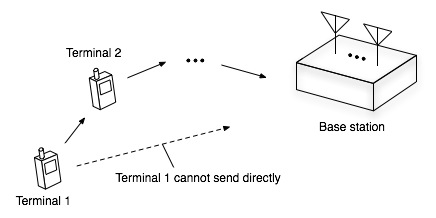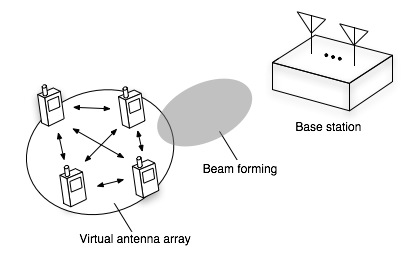協調無線
無線通信では、一般に送りたい情報を決められた周波数帯のキャリアに乗せて通信を行っています。高い周波数帯を用いる場合には周波数帯域幅をより広く設定できるため、更に高速な通信を行うことができます。しかし、周波数が高くなるに従い電波の減衰 (伝搬損失) が大きくなり、通信速度を維持するためにはより多くの送信電力が必要となります。特に、電源がバッテリーである携帯電話などの端末から基地局への通信 (上り回線) では、電力の制限が厳しく信頼性の高い通信を行うことが困難になると考えられます。
このような問題を解決するため、近年、協調無線と呼ばれる通信技術が注目されています。協調無線とは、近傍の複数の端末同士が互いに協力することで、低い送信電力でも基地局と信頼性の高い通信を実現する技術です。協調無線の代表的なものにマルチホップ伝送があります。これは、下図のように端末から基地局までの距離が遠く、通信品質が劣化する場合に、近傍の端末を中継局として経由し基地局まで信号を伝送する技術です。各端末は次の中継局までの信号伝送で済むため送信電力を低く抑えることができます。一方で、送信端末と基地局の間に複数の端末が存在する場合、その経路選択や中継方法、また、中継局が多い場合には伝送遅延やパケットロスなどが課題となります。
Cooperative Communications
General wireless communications need to modulate input data to the given carrier wave. When the carrier frequency is higher, we can set a wider frequency bandwidth for transmission, which enables us to achieve a higher data rate. However, a higher carrier frequency causes severe propagation loss, so that in such a case the transmitter needs higher transmit power to maintain the required data rate. In particular, a mobile terminal such as a cellular phone, of which power source is a battery, has a power constraint. Therefore, it is difficult to perform high-quality communications especially in the uplink, where the mobile terminal transmits its signal to a base station.
o solve the above issue, recently a technique called "cooperative communication" has drawn attention. The technique enables the mobile terminal to steadily communicate to the base station with low transmit power by cooperating with its neighboring terminals. A typical scheme in cooperative communications is "multi-hop" transmission. This is the scheme relaying the signal over multiple terminals from the transmitting terminal to the base station when the distance between them is too long to send directly, as shown in the figure below. Since each terminal sends the signal to a neighbor, we can keep the transmit power low. Meanwhile, we must raise the following issues to be addressed; route selection and relay schemes under multiple relay terminals, and also transmission delay or packet loss especially when the number of relay terminals is large.

マルチホップ伝送の概念図
Concept of multi-hop transmission.
これに対して、当研究室では、下図のように近傍の複数の端末間で相互通信により送信データを共有し、仮想的に一組のアンテナアレーとして動作させることにより高品質な通信を行うことを目指しています。この方式では、仮想的に複数のアンテナを用いてデータを送信するためスマートアンテナ技術を導入することができます。つまり、基地局 (受信側) が複数のアンテナを備える場合には送受信間は仮想的なMIMOシステムとなり、E-SDMなどのマルチビーム伝送を行うことにより伝送効率の向上が期待できます。しかし、仮想アンテナアレーにおける各送信アンテナは独立な端末であるため、高精度な信号伝送を行うためには端末間のキャリア周波数や位相、送信タイミングなどを合わせること (同期)、また、具体的な端末間のデータ共有方法についても検討する必要があります。当研究室では、このような課題を解決する手法を研究しています。
On the other hand, for more reliable transmission, our laboratory is aiming to form a "virtual antenna array" by an inter-terminal communication, where terminals share the transmitted data. The following figure illustrates the concept of the virtual antenna array. In this transmission scheme, we can apply the smart antenna technique to the antenna array, i.e., beamforming. Moreover, when multiple antennas are installed also at the base station, namely at the receiver, the system can be assumed as a virtual MIMO system, where we can perform multi-beamforming such as E-SDM for more improvement in transmission efficiency. Since each transmit antenna is actually an independent terminal, however, we have to synchronize their carrier frequencies, phases, and transmit timing among the terminals for accurately operating them as an antenna array. Moreover, practical schemes sharing the transmitted data among the terminals should be examined. We have studied virtual array systems and techniques to solve these issues.

仮想アンテナアレーの概念図
Concept of a virtual antenna array.
[文献]
小川健太, 小川恭孝, 大鐘, 西村, "仮想アンテナアレーを用いた送信ビーム形成に関する基礎的検討," 信学技報, vol. 106, no. 555, RCS2006-251, pp. 65-68, March 2007.
斉藤裕大, 小川, 大鐘, 西村, "仮想MIMOシステムにおける端末周波数オフセットの影響を補償する上り回線ウエイトの検討," 信学技報, vol. 107, no. 305, AP2007-107, pp. 31-36, Nov. 2007.
